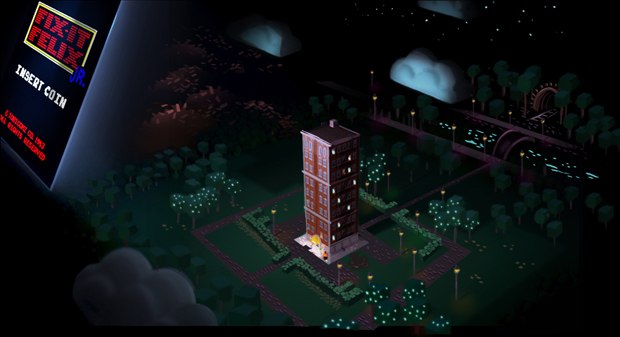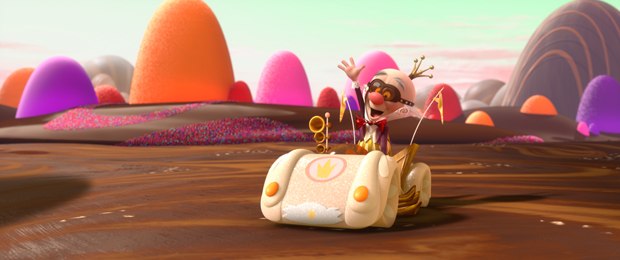Disney's definitely back with Wreck-It Ralph and I talk to director Rich Moore and the animators about the latest rebirth of animation.

When John Lasseter first pitched Rich Moore the concept for a Disney animated movie about an 8-bit video game adventure, the TV refugee from The Simpsons and Futurama took to it instantly. It was different and wide open to subversive possibilities, not the least of which was the notion of a baddie who wants to break free from a successful rut to become a hero. Moore longed to direct a feature but, until Lasseter hired him, he wasn't sure it was ever going to happen.
But little did Moore realize how Wreck-It Ralph would turn the Disney ethos on its head while simultaneously embracing its legacy. At first glance, you'd almost think this was a Pixar movie with its smart and witty premise (video game characters coming to life after dark in an adventurous rite of passage) until digging deeper and discovering the Disney DNA at its core. Wreck-It Ralph is smart and funny: "a mangy dog chasing a cautionary tale."
"I think the Disney movies have taken an interesting direction after coming out of the woods and feeling their way," Moore suggests. "I credit Ed [Catmull] and John [Lasseter] coming in [from Pixar] and slowly riding the path. I think Tangled really laid it right at the feet of the audience, saying: 'This is a studio that you love and remember and we're back making things that are relevant.' I didn't like the fact that Disney was taking a relentless beating from some of the other studios. It basically used what Disney did well to beat them into submission. But it was never a goal of mine to work at the studio. I'll be frank: In the '90s, the movies they were making were not my cup of tea. But as an outsider who was able to see Disney [trying to recover], I liked how they were the underdog with something to prove. They were small and scrappy and wanted to do good. And Disney is in that place right now."
As part of this ambitious experiment, Moore and the Disney team have crafted a dazzling video game universe with three distinct worlds (the 8-bit Nicelanders of Fix-It Felix Jr., the photo real first-person shooter, Hero's Duty and the Candy Land-inspired Sugar Rush). Plus they've made a smart and heart-warming tale of two social misfits (the hulk-like baddie, Ralph, and the snarky little Vanellope) banding together to reboot their lives and save their universe from a Cy-Bug invasion.
More important, Moore has helped put Disney back on track toward animation greatness. Moore's a hand-drawn guy who's taken to CG with warmth and affection. But, stylistically, he's infused CG with a 2D aesthetic that's fresh and funny. What's old is new again. One look at Felix and King Candy and you immediately sense the influence of Ward Kimball. Indeed, King Candy is an obvious homage to The Mad Hatter from Alice in Wonderland right down to Ed Wynn's whimsical voice. Like Glen Keane on Tangled, Moore drew over the CG footage on the tablets to get more of a hand-drawn performance out of his characters, but here it was to get more of a snap. They even created a new position called effects designer, who did draw-overs for the Sugar Rush racing sequences so they had more snap.
Each world has its own look and shape language: "Niceland was built in the computer with a modeler in two hours," says art director and Disney vet Mike Gabriel, who, like Moore, made the transition from hand-drawn to CG. It's a very simple square but every detail had to bolster the 8-bit effect. But the biggest animation challenge turned out to be the Nicelanders. Getting the right staccato motion took several iterations. In the end, they even Disneyfied it with the right flourish.
"Hero's Duty was comprised of aggressive triangles and it's weathered, torn up, full of grime and grit," Gabriel adds. "Sugar Rush is made of broken ceramics and organic shapes in the shape of an O. It's a caricature of candy using the architecture of Barcelona. Even pollution is a pretty candy cane forest."
Keeping the characters distinct was the biggest concern, according to animation supervisor Renato dos Anjos. "Ralph is a cartoony [mountain man], Calhoun is more realistic [as a soldier] and Vanellope is more musical and cartoony [with a Japanese influence]. It was a challenge for the animators to constantly remind themselves what style of animation they were working in."
Likewise, even the VFX had to be stylistically different in each world. In fact, this is the first Disney animated movie with two supervisors. "For Niceland, in particular, it took a lot of fire and smoke iterations to get it right," explains supervisor Cesar Velazquez, who split duties with David Hutchins. "It had that staccato motion to objects, really keeping the look of things simple. One of the animators from video games came up with a design that fit the world. There was a lot more destruction to sets so we developed new technology for destruction of objects and buildings. With so much smoke, haze and clouds, we developed a new pipeline for volumetric rendering."
However, Disney's biggest advancement was a new virtual camera for hand-held work on Hero's Duty, headed by Evan Goldberg, manager of animation technology. Introducing capture technology into the studio's feature animation pipeline proved challenging, but was well worth it, considering the dynamic advantages you get with the new system: a digital scouting device, closer involvement for Moore, and hundreds of takes in an hour, the ability to scale a virtual world up and down, and translate and rotate it with unparalleled camera polish.
When I started at the studio, it was like finding some amazing toy train that wasn't being fully utilized," Moore concludes. "Tangled started to get the pieces all back together but collectively I think we've now got this beautiful machine working again. And Chris Buck with Frozen after this looks gorgeous and we have some other movies coming down the line that people are really proud of. Knock on wood, if this does well, I would love to revisit this universe because I love the characters and the team that we built."
--
Bill Desowitz is former senior editor of AWN and VFXWorld, the owner of Immersed in Movies (www.billdesowitz.com), a columnist for Thompson on Hollywood at Indiewire and author of James Bond Unmasked (www.jamesbondunmasked.com), which chronicles the 50-year evolution of 007 on screen, featuring interviews with all six actors.














